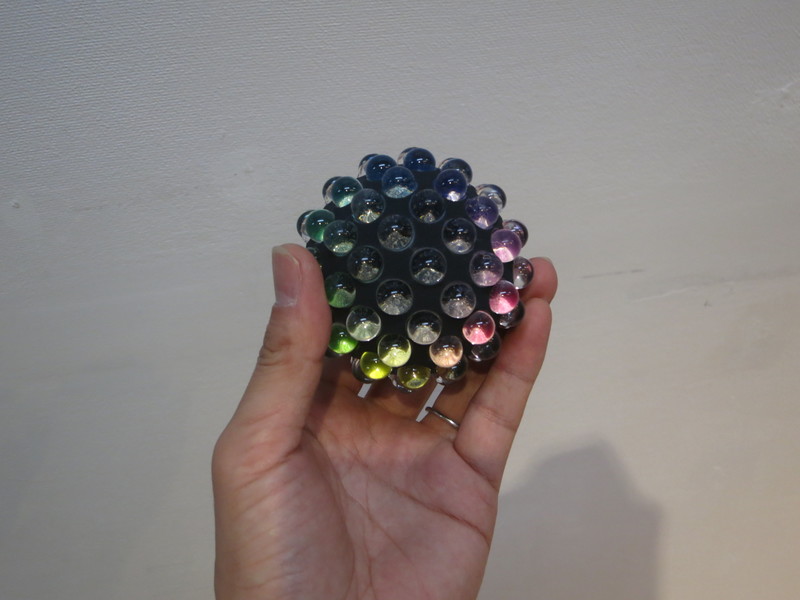Interviews

Color-changing Unit Modules Put Beauty in the Eye of the Beholder (Part 1)
Jun Fujiki
It's all a Matter of Perspective.
Interviewer & Japanese Writer: Yamamoto Takaya; Translation & Editing: Matthew Cherry
Jun Fujiki was selected to participate in the 2016 INNO-vation Program’s Disruptive Challenge with his proposal titled Development of a Three-dimensional Object Building Unit Module that Changes Color Based on Time & Perspective. To create one of these modules, a transparent acrylic sphere is placed into an indentation. The color of the acrylic sphere changes based on the viewer’s perspective. If a three-dimensional object is covered with these spheres, the entire object’s color appears to change depending on the viewing angle.

The color changes on this acrylic sphere based on the viewer’s perspective
The fundamental principle driving this technology is that the surface of the indentation is carefully mapped with a set of calculated colors. The color being magnified by the acrylic sphere then appears to change based on where the viewer is looking from. Although there are existing technologies that change color on a two-dimensional scale, what sets Fujiki’s invention apart is that this concept is applicable to three-dimensional objects.

A unit made from several acrylic spheres
Fujiki was originally involved in research using 3D Computer Graphics. He was the developer of the free software OLE Coordinate System (referred to below as OLE).
M.C. Escher, famous for his trompe-l'œil artwork, created a lithograph print called Ascending and Descending, which features a square-shaped staircase circling in on itself. The people pictured in the print traversing the staircase appear to be ascending and descending the same staircase in an endless loop. It’s an optical illusion that tricks the brain into thinking that what appears to be impossible in three dimensions is possible in two dimensions.
OLE uses this same concept. Users of the software manipulate on-screen characters across paths of optical illusions. Characters can jump off paths and land right back where they started, or continue across impassable roads by changing the perspective they’re viewed from.
“Connecting pathways that have been broken [by changing perspective] is a pretty impossible concept in terms of three-dimensional space. In a two-dimensional space the idea becomes more viable. These impossible phenomena that occur in the gap between the second and third dimensions are quite fascinating,” Fujiki explained. OLE was later used to develop the PSP game Echochrome, which spawned an enthusiastic fan following.
Fujiki had always been interested in three-dimensional objects, and he majored in product design when he was a university student. Although OLE turned out to be a video game, he still couldn’t help but wonder if he could apply the same concept to real three-dimensional objects. That’s when he had the inspiration to create an object that would change color depending on the viewer’s perspective.
There were already plenty of products on the market, such as sheets and film, that changed color depending on perspective. These products were two-dimensional; the concept had yet to be realized in a three-dimensional form.
When light is passed through a transparent sphere, it seems to bend as it refracts. Using this same principle, when a transparent acrylic sphere is placed in a depression containing many different colors, the refraction of light changes the color of the sphere depending on what angle it’s viewed from. Using a depression and an acrylic sphere together as one module and combining several of them together creates a three-dimensional object that changes color based on perspective.
Fujiki was able to create this kind of technology without any major difficulties. However, he wanted to make an object that changed color not only based on perspective but other factors as well. He decided to try his hand at the INNO-vation Program.
In part 2, we’ll ask Fujiki about his development period within the INNO-vation Program.

Jun Fujiki’s Profile

